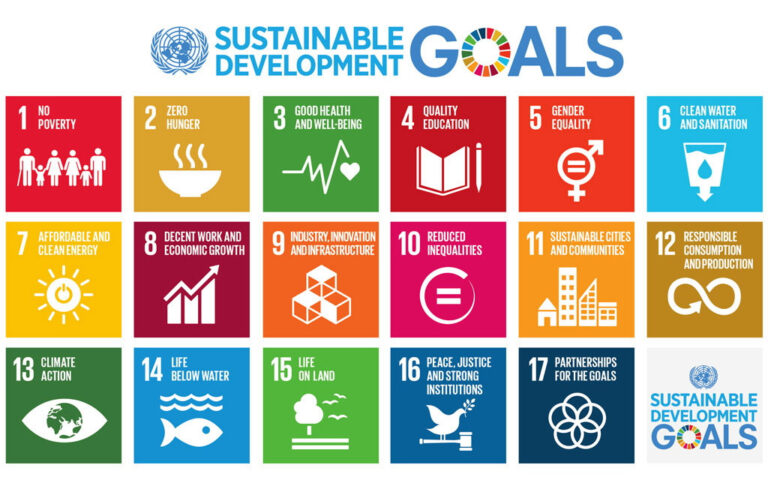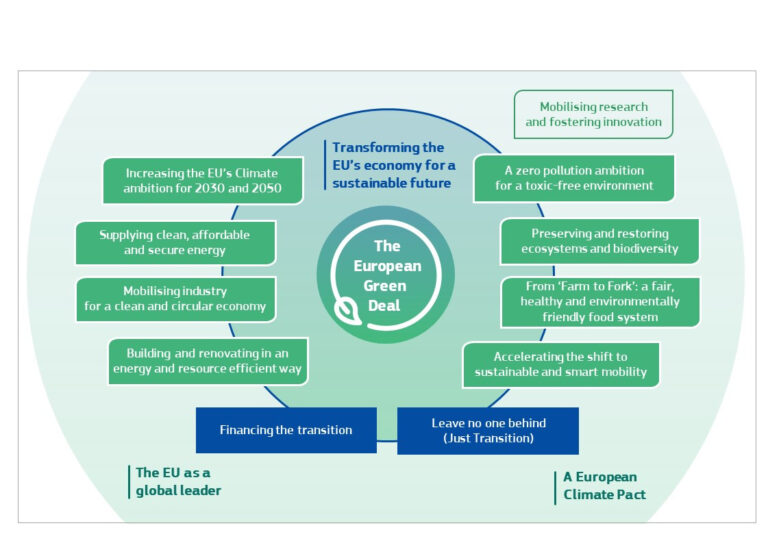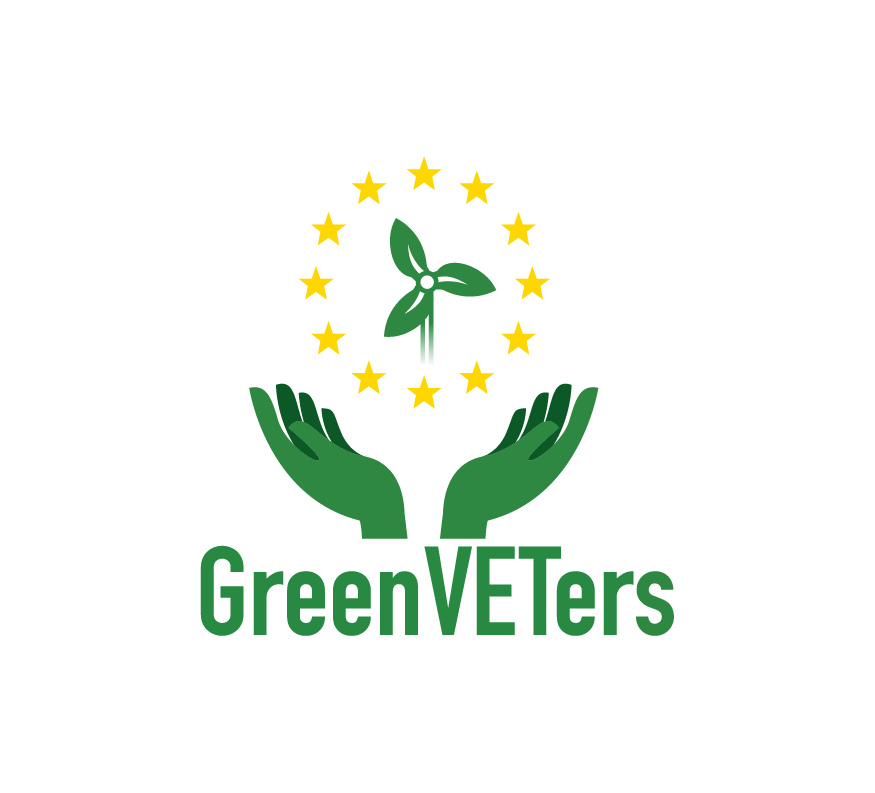Worksheet for Lesson 2:
The UN’s Sustainable Development Goals and the European Green Deal
Learning Objectives:
1. Students learn about the UN’s 2030 Agenda for Sustainable Development
2. Students learn that the EGD was created to integrate the UN’s SDGs in EU policy
3. Students are introduced to some of the plans, regulations, packages, etc. under the EGD
What is the UN’s 2030 Agenda for Sustainable Development?
The United Nations’ 2030 Agenda for Sustainable Development, also known as the Sustainable Development Goals (SDGs), is a set of 17 global goals adopted by the UN in 2015 to end poverty, protect the planet, and ensure that all people enjoy peace and prosperity by 2030.
The SDGs are a universal call to action to end poverty, protect the planet, and ensure that all people enjoy peace and prosperity by 2030. The 17 goals are:
1. No Poverty
2. Zero Hunger
3. Good Health and Well-being
4. Quality Education
5. Gender Equality
6. Clean Water and Sanitation
7. Affordable and Clean Energy
8. Decent Work and Economic Growth
9. Industry, Innovation and Infrastructure
10. Reduced Inequalities
11. Sustainable Cities and Communities
12. Responsible Consumption and Production
13. Climate Action
14. Life Below Water
15. Life On Land
16. Peace, Justice and Strong Institutions
17. Partnerships for the Goals
The SDGs are designed to be integrated and indivisible, meaning that progress towards one goal can support progress towards other goals. For example, increasing access to education can help reduce poverty and hunger, and protecting the planet’s biodiversity can help improve people’s health and well-being.
The SDGs are also designed to be inclusive and leave no one behind, meaning that efforts to achieve the goals must be tailored to the specific needs of different countries, regions, and groups of people, and must take into account the different ways that different groups are affected by poverty, hunger, health and environmental problems, and other challenges.
Governments, civil society organizations, the private sector, and individual citizens all have a role to play in achieving the SDGs. The UN encourages all actors to take action to achieve the goals and to report on their progress through the Voluntary National Reviews.
The SDGs are ambitious, and achieving them will require significant efforts from all actors. However, we must take action now to ensure that we leave a better world for future generations.
How can students learn about the UN’s 2030 Agenda for Sustainable Development?

Τhe European Green Deal
The benefits of the European Green Deal
The European Green Deal will improve the well-being and health of citizens and future generations by providing:
• fresh air, clean water, healthy soil, and biodiversity
• renovated, energy efficient buildings
• healthy and affordable food
• expanded public transportation system
• cleaner energy and cutting-edge clean technological innovation
• longer lasting products that can be repaired, recycled, and re-used
• future-proof jobs and skills training for the transition
• globally competitive and resilient industry

European Green Deal - Strategies
1) The EU Circular Economy Action Plan (CEAP) was created to increase global competitiveness, promote sustainable economic growth, and create new jobs. The CEAP focuses on resource-intensive industries -meaning industries that produce the resources and supplies of other industries- with strong circularity potential, to keep resources in economic cycles for as long as feasible. The Commission will implement all 35 actions listed in the action plan. Measures that will be introduced under the new action plan aim to make sustainable products the norm in the EU:
• empower consumers and public buyers
• focus on the sectors that use the most resources and where the potential for circularity is high such as electronics and ICT, batteries and vehicles, packaging, plastics, textiles, construction and buildings, food, water and nutrients
• ensure less waste
• make circularity work for people, regions and cities
• lead global efforts on circular economy
2) The Regulation on Eco-design for Sustainable Products (ESPR) addresses the fact that product design can account for up to 80% of a product’s environmental impact. ESPR establishes new standards for the product design phase, that ensure durability, dependability, reusability, reparability, ease of maintenance, refurbishment, recycling, and energy efficiency.
3) The “Farm to Fork Strategy” was established to ensure that agriculture, fisheries, aquaculture and the food value chain correctly contribute to the goal of a climate- neutral EU by 2050. The Strategy addresses food safety and affordability, the minimization of pesticide use, the promotion of organic farming, the reduction of food waste and loss and the improvement of animal welfare.
4) The 2030 Biodiversity Strategy is a thorough, ambitious long-term plan aiming at the preservation of the environment, the prevention of ecosystem loss and the restoration of Europe’s biodiversity by 2030.
5) The Zero Pollution Action Plan serves as a guide, mainly for the integration of pollution prevention into all pertinent EU programs. The plan contains goals for waste production, biodiversity, and pollution of the air, water, soil, and noise.
To ensure that EU policies are in line with the climate goals that the Council and the European Parliament agreed upon, the Fit for 55 packages is a set of 13 legislative proposals to review and update EU legislation and implement new initiatives. The package has been approved in 2021 and aims to make the EU’s climate, energy, land use, transportation, and taxation policies suitable for reducing greenhouse gas emissions by at least 55% by 2030.
REFERENCES
https://greenveters.cip-projects.eu/2022/11/15/the-european-green-deal-and-greenveters/
https://www.eera-set.eu/about-us/eera-in-context/eu-2050-strategy.html
https://www.un.org/development/desa/disabilities/envision2030.html
It's Quiz Time!
Here’s a fun quiz that you could use to test your understanding of the key concepts covered in this lesson:
Quiz Summary
0 of 5 Questions completed
Questions:
Information
You have already completed the quiz before. Hence you can not start it again.
Quiz is loading…
You must sign in or sign up to start the quiz.
You must first complete the following:
Results
Results
0 of 5 Questions answered correctly
Your time:
Time has elapsed
You have reached 0 of 0 point(s), (0)
Earned Point(s): 0 of 0, (0)
0 Essay(s) Pending (Possible Point(s): 0)
Categories
- Not categorized 0%
- 1
- 2
- 3
- 4
- 5
- Current
- Review
- Answered
- Correct
- Incorrect
-
Question 1 of 5
1. Question
What is the UN’s 2030 Agenda for Sustainable Development?
CorrectIncorrect -
Question 2 of 5
2. Question
What is the contribution of the Council of Europe to the UN’s 2030 SDGs?
CorrectIncorrect -
Question 3 of 5
3. Question
What is the European Green Deal?
CorrectIncorrect -
Question 4 of 5
4. Question
What are some benefits of the European Green Deal?
CorrectIncorrect -
Question 5 of 5
5. Question
What are some strategies of the European Green Deal?
CorrectIncorrect





